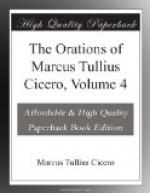LVIII. But what feet ought to be mingled with others, like purple, must be now explained; and we must also show to what kind of speech each sort of foot and rhythm is the best adapted. For the iambic is most frequent in those orations which are composed in a humble and lowly style; but the paeon is suited to a more dignified style; and the dactyl to both. Therefore, in a varied and long-continued speech these feet should be mingled together and combined. And in this way the fact of the orator aiming at pleasing the senses, and the careful attempt to round off the speech, will be the less visible, and they will at all times be less apparent if we employ dignified expressions and sentiments. For the hearers observe these two things, and think them agreeable: (I mean, expressions and sentiments.) And while they listen to them with admiring minds, the rhythm escapes their notice; and even if it were wholly wanting they would still be delighted with those other things.
Nor indeed is the rhythm, I mean in a speech, (for the case as to verse is very different,) so exacting that nothing may ever be expressed except according to rule; for then it would be a poem. But every oration which does not halt or if I may so say, fluctuate, and which proceeds on with an equal and consistent pace, is considered rhythmical. And it is considered rhythmical in the delivery; not because it consists wholly of some regular rhythm; but because it comes as near to a musical rhythm as possible: on which account it is more difficult to make a speech than to make verses; because these last have certain definite rules which it is necessary to follow; but, in speaking, there is nothing settled, except that the speech must not be intemperate, or too compressed, or prosaic, or too fluent. Therefore there are no regular bars in it as a flute-player has; but the whole principle and system of an oration is regulated by general rules of universal application; and they are judged of on the principle of pleasing the ear.
LIX. But people often ask, whether in every portion of a paragraph it is necessary to have a regard to rhythm, or whether it is sufficient to do so at the beginning and end of a sentence. For many people think that it is sufficient for a sentence to end and be wound up in a rhythmical manner. But although that is the main point, it is not the only one; for the sounding of the periods is only to be laid aside, not to be thrown away. And therefore, as men’s ears are always on the watch for the end of a sentence, and are greatly influenced by that, that certainly ought never to be devoid of rhythm; but harmony ought to pervade the whole sentence from beginning to end; and the whole ought to proceed from the beginning so naturally that the end shall be consistent with every previous part. But that will not be difficult to men who have been trained in a good school, who have written many things, and who have made also all the speeches which they have delivered without written




